Business Economics Assignment Report: Externality, Inflation, Wage
VerifiedAdded on 2023/03/20
|20
|3795
|74
Report
AI Summary
This comprehensive business economics report, prepared for the BEO6600 course, delves into three core economic topics: externalities, inflation, and minimum wage. The externality section analyzes negative externalities associated with Melbourne Airport's pollution, market failures, and market-based solutions like taxes and transferable permits. The inflation section differentiates between monetary and inflation targeting policies, explores the causes of demand-pull and cost-push inflation, and examines the effects of a cash rate cut. Finally, the minimum wage section discusses its advantages for employers and the overall economic impact. The report provides figures and diagrams to illustrate key concepts, offering a detailed analysis of economic principles and their practical implications. The report is a valuable resource for students seeking to understand and apply economic concepts.
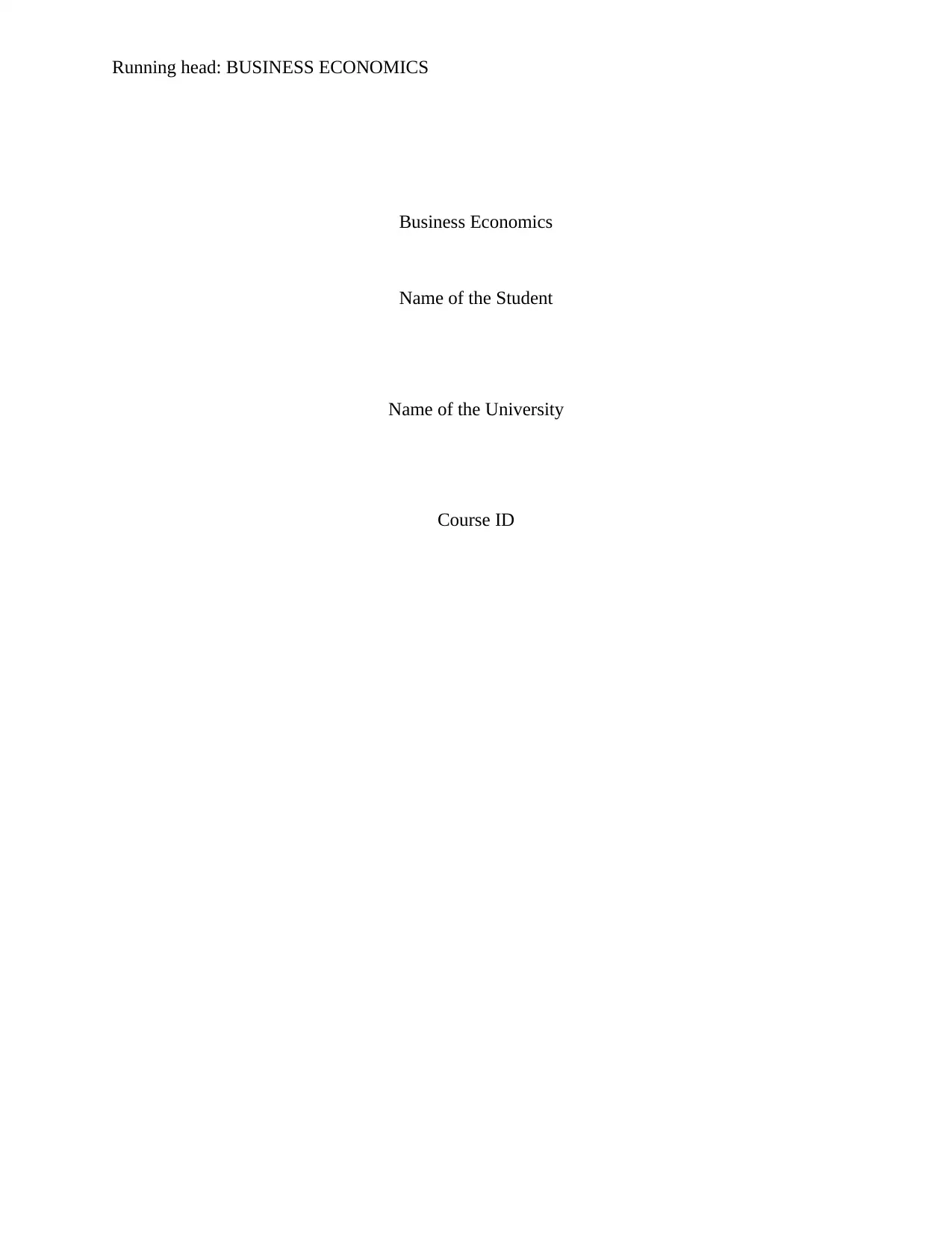
Running head: BUSINESS ECONOMICS
Business Economics
Name of the Student
Name of the University
Course ID
Business Economics
Name of the Student
Name of the University
Course ID
Paraphrase This Document
Need a fresh take? Get an instant paraphrase of this document with our AI Paraphraser
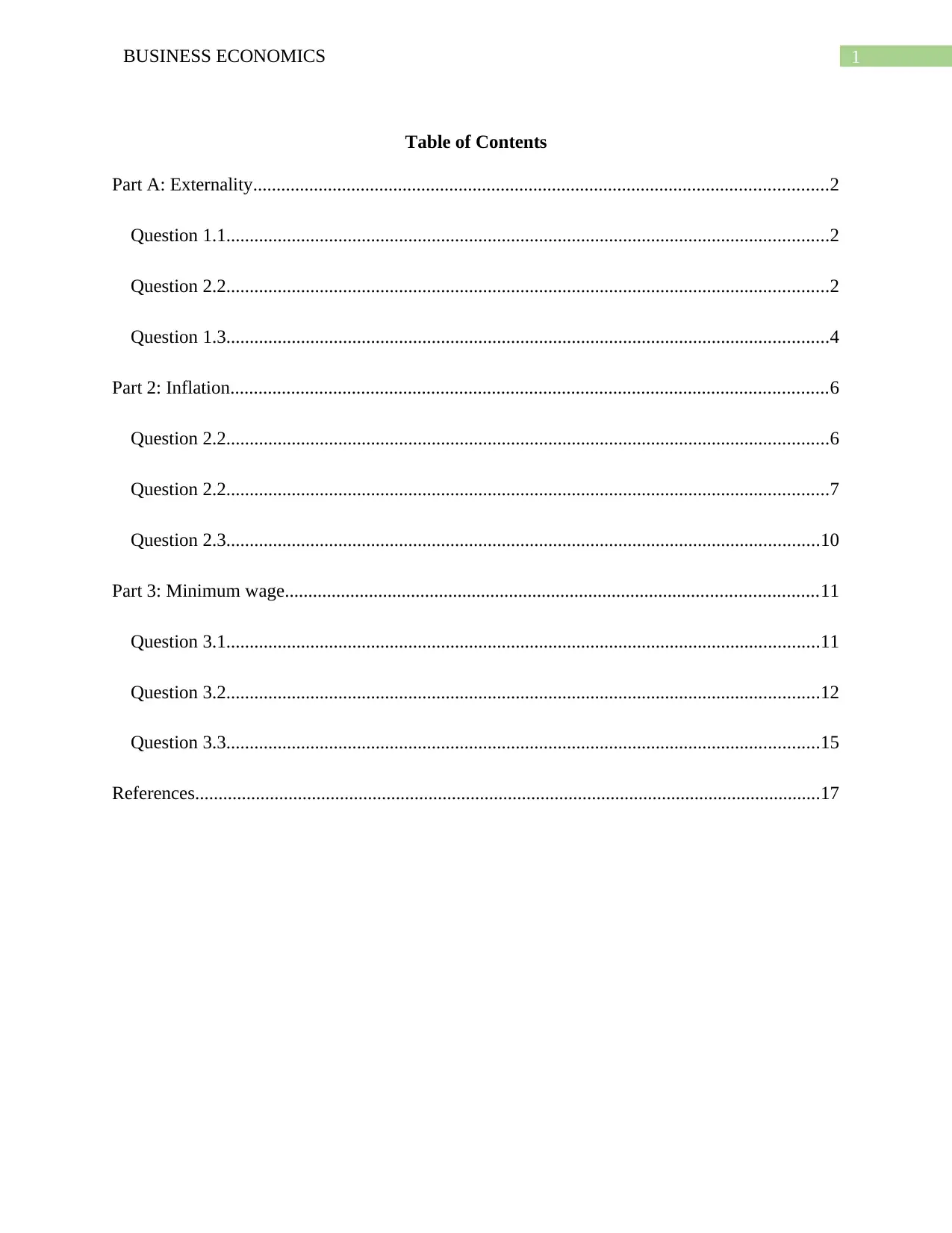
1BUSINESS ECONOMICS
Table of Contents
Part A: Externality...........................................................................................................................2
Question 1.1.................................................................................................................................2
Question 2.2.................................................................................................................................2
Question 1.3.................................................................................................................................4
Part 2: Inflation................................................................................................................................6
Question 2.2.................................................................................................................................6
Question 2.2.................................................................................................................................7
Question 2.3...............................................................................................................................10
Part 3: Minimum wage..................................................................................................................11
Question 3.1...............................................................................................................................11
Question 3.2...............................................................................................................................12
Question 3.3...............................................................................................................................15
References......................................................................................................................................17
Table of Contents
Part A: Externality...........................................................................................................................2
Question 1.1.................................................................................................................................2
Question 2.2.................................................................................................................................2
Question 1.3.................................................................................................................................4
Part 2: Inflation................................................................................................................................6
Question 2.2.................................................................................................................................6
Question 2.2.................................................................................................................................7
Question 2.3...............................................................................................................................10
Part 3: Minimum wage..................................................................................................................11
Question 3.1...............................................................................................................................11
Question 3.2...............................................................................................................................12
Question 3.3...............................................................................................................................15
References......................................................................................................................................17
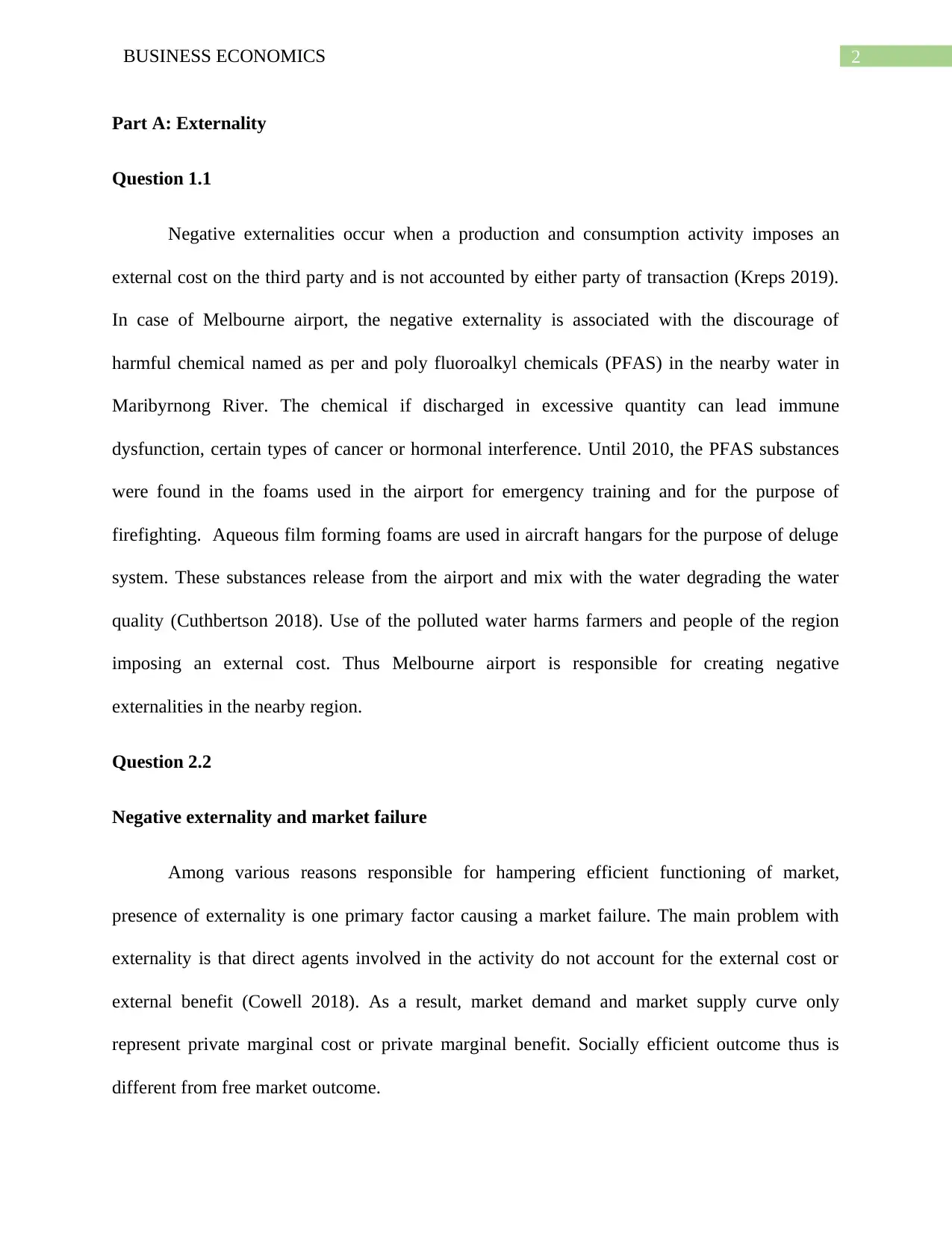
2BUSINESS ECONOMICS
Part A: Externality
Question 1.1
Negative externalities occur when a production and consumption activity imposes an
external cost on the third party and is not accounted by either party of transaction (Kreps 2019).
In case of Melbourne airport, the negative externality is associated with the discourage of
harmful chemical named as per and poly fluoroalkyl chemicals (PFAS) in the nearby water in
Maribyrnong River. The chemical if discharged in excessive quantity can lead immune
dysfunction, certain types of cancer or hormonal interference. Until 2010, the PFAS substances
were found in the foams used in the airport for emergency training and for the purpose of
firefighting. Aqueous film forming foams are used in aircraft hangars for the purpose of deluge
system. These substances release from the airport and mix with the water degrading the water
quality (Cuthbertson 2018). Use of the polluted water harms farmers and people of the region
imposing an external cost. Thus Melbourne airport is responsible for creating negative
externalities in the nearby region.
Question 2.2
Negative externality and market failure
Among various reasons responsible for hampering efficient functioning of market,
presence of externality is one primary factor causing a market failure. The main problem with
externality is that direct agents involved in the activity do not account for the external cost or
external benefit (Cowell 2018). As a result, market demand and market supply curve only
represent private marginal cost or private marginal benefit. Socially efficient outcome thus is
different from free market outcome.
Part A: Externality
Question 1.1
Negative externalities occur when a production and consumption activity imposes an
external cost on the third party and is not accounted by either party of transaction (Kreps 2019).
In case of Melbourne airport, the negative externality is associated with the discourage of
harmful chemical named as per and poly fluoroalkyl chemicals (PFAS) in the nearby water in
Maribyrnong River. The chemical if discharged in excessive quantity can lead immune
dysfunction, certain types of cancer or hormonal interference. Until 2010, the PFAS substances
were found in the foams used in the airport for emergency training and for the purpose of
firefighting. Aqueous film forming foams are used in aircraft hangars for the purpose of deluge
system. These substances release from the airport and mix with the water degrading the water
quality (Cuthbertson 2018). Use of the polluted water harms farmers and people of the region
imposing an external cost. Thus Melbourne airport is responsible for creating negative
externalities in the nearby region.
Question 2.2
Negative externality and market failure
Among various reasons responsible for hampering efficient functioning of market,
presence of externality is one primary factor causing a market failure. The main problem with
externality is that direct agents involved in the activity do not account for the external cost or
external benefit (Cowell 2018). As a result, market demand and market supply curve only
represent private marginal cost or private marginal benefit. Socially efficient outcome thus is
different from free market outcome.
⊘ This is a preview!⊘
Do you want full access?
Subscribe today to unlock all pages.

Trusted by 1+ million students worldwide
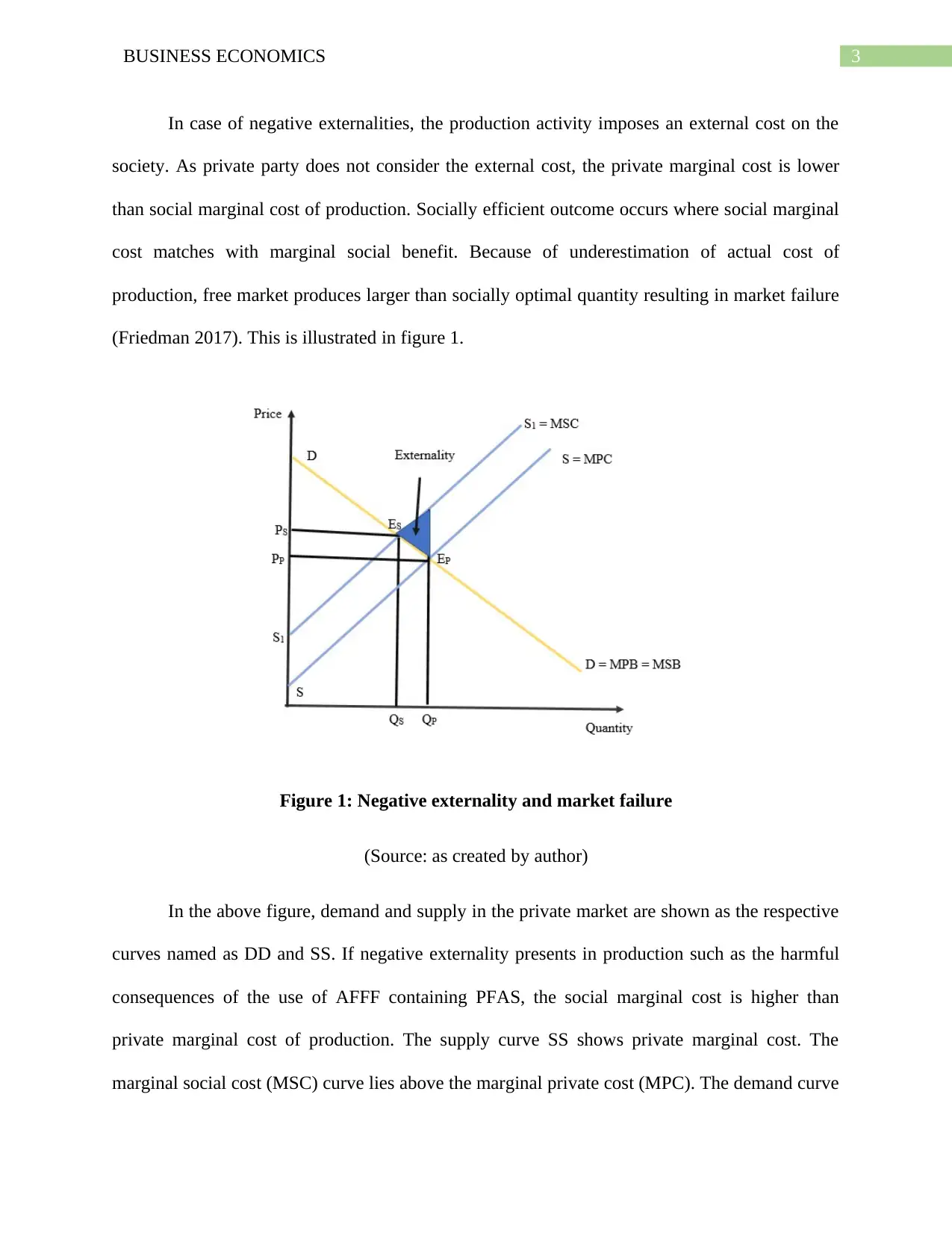
3BUSINESS ECONOMICS
In case of negative externalities, the production activity imposes an external cost on the
society. As private party does not consider the external cost, the private marginal cost is lower
than social marginal cost of production. Socially efficient outcome occurs where social marginal
cost matches with marginal social benefit. Because of underestimation of actual cost of
production, free market produces larger than socially optimal quantity resulting in market failure
(Friedman 2017). This is illustrated in figure 1.
Figure 1: Negative externality and market failure
(Source: as created by author)
In the above figure, demand and supply in the private market are shown as the respective
curves named as DD and SS. If negative externality presents in production such as the harmful
consequences of the use of AFFF containing PFAS, the social marginal cost is higher than
private marginal cost of production. The supply curve SS shows private marginal cost. The
marginal social cost (MSC) curve lies above the marginal private cost (MPC). The demand curve
In case of negative externalities, the production activity imposes an external cost on the
society. As private party does not consider the external cost, the private marginal cost is lower
than social marginal cost of production. Socially efficient outcome occurs where social marginal
cost matches with marginal social benefit. Because of underestimation of actual cost of
production, free market produces larger than socially optimal quantity resulting in market failure
(Friedman 2017). This is illustrated in figure 1.
Figure 1: Negative externality and market failure
(Source: as created by author)
In the above figure, demand and supply in the private market are shown as the respective
curves named as DD and SS. If negative externality presents in production such as the harmful
consequences of the use of AFFF containing PFAS, the social marginal cost is higher than
private marginal cost of production. The supply curve SS shows private marginal cost. The
marginal social cost (MSC) curve lies above the marginal private cost (MPC). The demand curve
Paraphrase This Document
Need a fresh take? Get an instant paraphrase of this document with our AI Paraphraser
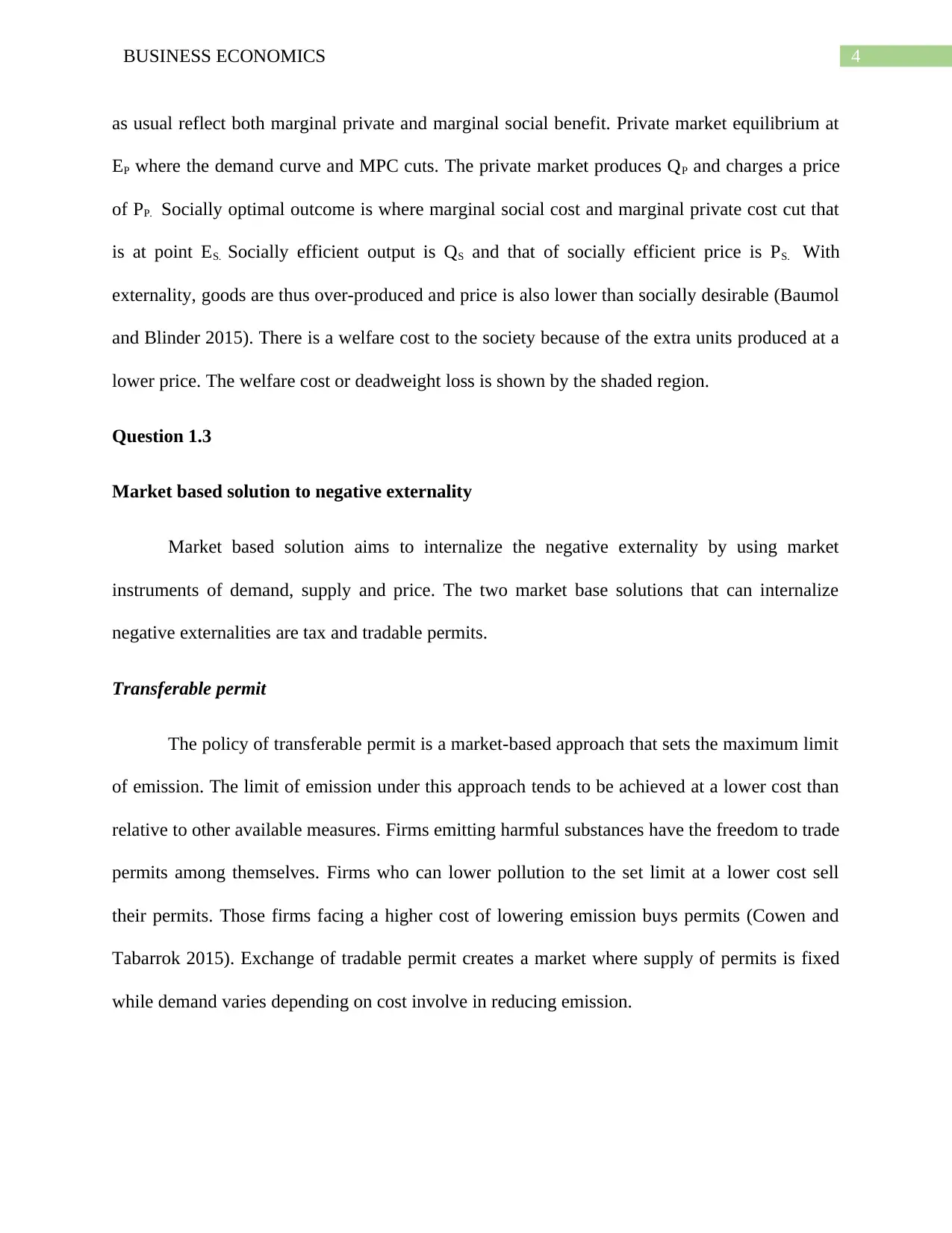
4BUSINESS ECONOMICS
as usual reflect both marginal private and marginal social benefit. Private market equilibrium at
EP where the demand curve and MPC cuts. The private market produces QP and charges a price
of PP. Socially optimal outcome is where marginal social cost and marginal private cost cut that
is at point ES. Socially efficient output is QS and that of socially efficient price is PS. With
externality, goods are thus over-produced and price is also lower than socially desirable (Baumol
and Blinder 2015). There is a welfare cost to the society because of the extra units produced at a
lower price. The welfare cost or deadweight loss is shown by the shaded region.
Question 1.3
Market based solution to negative externality
Market based solution aims to internalize the negative externality by using market
instruments of demand, supply and price. The two market base solutions that can internalize
negative externalities are tax and tradable permits.
Transferable permit
The policy of transferable permit is a market-based approach that sets the maximum limit
of emission. The limit of emission under this approach tends to be achieved at a lower cost than
relative to other available measures. Firms emitting harmful substances have the freedom to trade
permits among themselves. Firms who can lower pollution to the set limit at a lower cost sell
their permits. Those firms facing a higher cost of lowering emission buys permits (Cowen and
Tabarrok 2015). Exchange of tradable permit creates a market where supply of permits is fixed
while demand varies depending on cost involve in reducing emission.
as usual reflect both marginal private and marginal social benefit. Private market equilibrium at
EP where the demand curve and MPC cuts. The private market produces QP and charges a price
of PP. Socially optimal outcome is where marginal social cost and marginal private cost cut that
is at point ES. Socially efficient output is QS and that of socially efficient price is PS. With
externality, goods are thus over-produced and price is also lower than socially desirable (Baumol
and Blinder 2015). There is a welfare cost to the society because of the extra units produced at a
lower price. The welfare cost or deadweight loss is shown by the shaded region.
Question 1.3
Market based solution to negative externality
Market based solution aims to internalize the negative externality by using market
instruments of demand, supply and price. The two market base solutions that can internalize
negative externalities are tax and tradable permits.
Transferable permit
The policy of transferable permit is a market-based approach that sets the maximum limit
of emission. The limit of emission under this approach tends to be achieved at a lower cost than
relative to other available measures. Firms emitting harmful substances have the freedom to trade
permits among themselves. Firms who can lower pollution to the set limit at a lower cost sell
their permits. Those firms facing a higher cost of lowering emission buys permits (Cowen and
Tabarrok 2015). Exchange of tradable permit creates a market where supply of permits is fixed
while demand varies depending on cost involve in reducing emission.
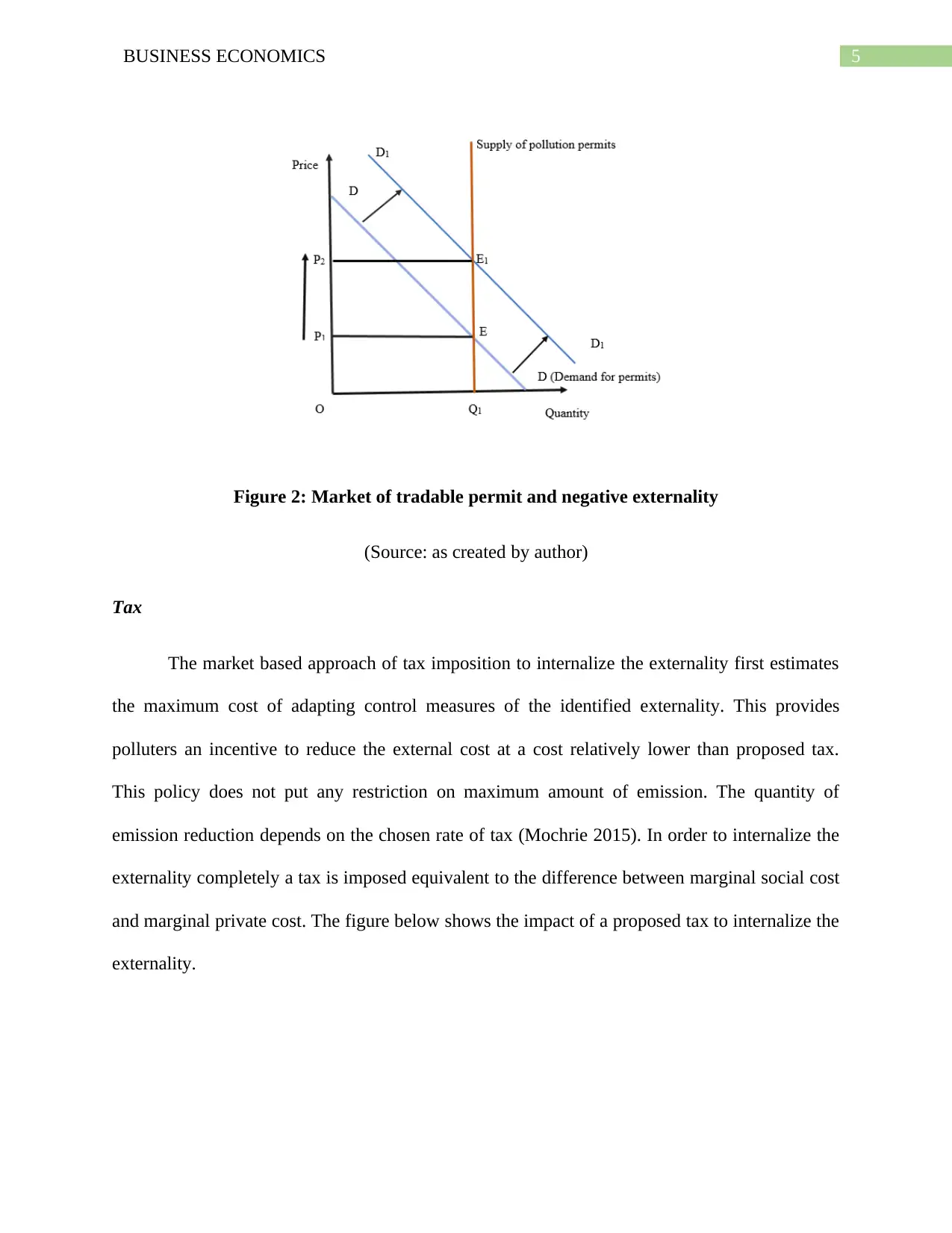
5BUSINESS ECONOMICS
Figure 2: Market of tradable permit and negative externality
(Source: as created by author)
Tax
The market based approach of tax imposition to internalize the externality first estimates
the maximum cost of adapting control measures of the identified externality. This provides
polluters an incentive to reduce the external cost at a cost relatively lower than proposed tax.
This policy does not put any restriction on maximum amount of emission. The quantity of
emission reduction depends on the chosen rate of tax (Mochrie 2015). In order to internalize the
externality completely a tax is imposed equivalent to the difference between marginal social cost
and marginal private cost. The figure below shows the impact of a proposed tax to internalize the
externality.
Figure 2: Market of tradable permit and negative externality
(Source: as created by author)
Tax
The market based approach of tax imposition to internalize the externality first estimates
the maximum cost of adapting control measures of the identified externality. This provides
polluters an incentive to reduce the external cost at a cost relatively lower than proposed tax.
This policy does not put any restriction on maximum amount of emission. The quantity of
emission reduction depends on the chosen rate of tax (Mochrie 2015). In order to internalize the
externality completely a tax is imposed equivalent to the difference between marginal social cost
and marginal private cost. The figure below shows the impact of a proposed tax to internalize the
externality.
⊘ This is a preview!⊘
Do you want full access?
Subscribe today to unlock all pages.

Trusted by 1+ million students worldwide
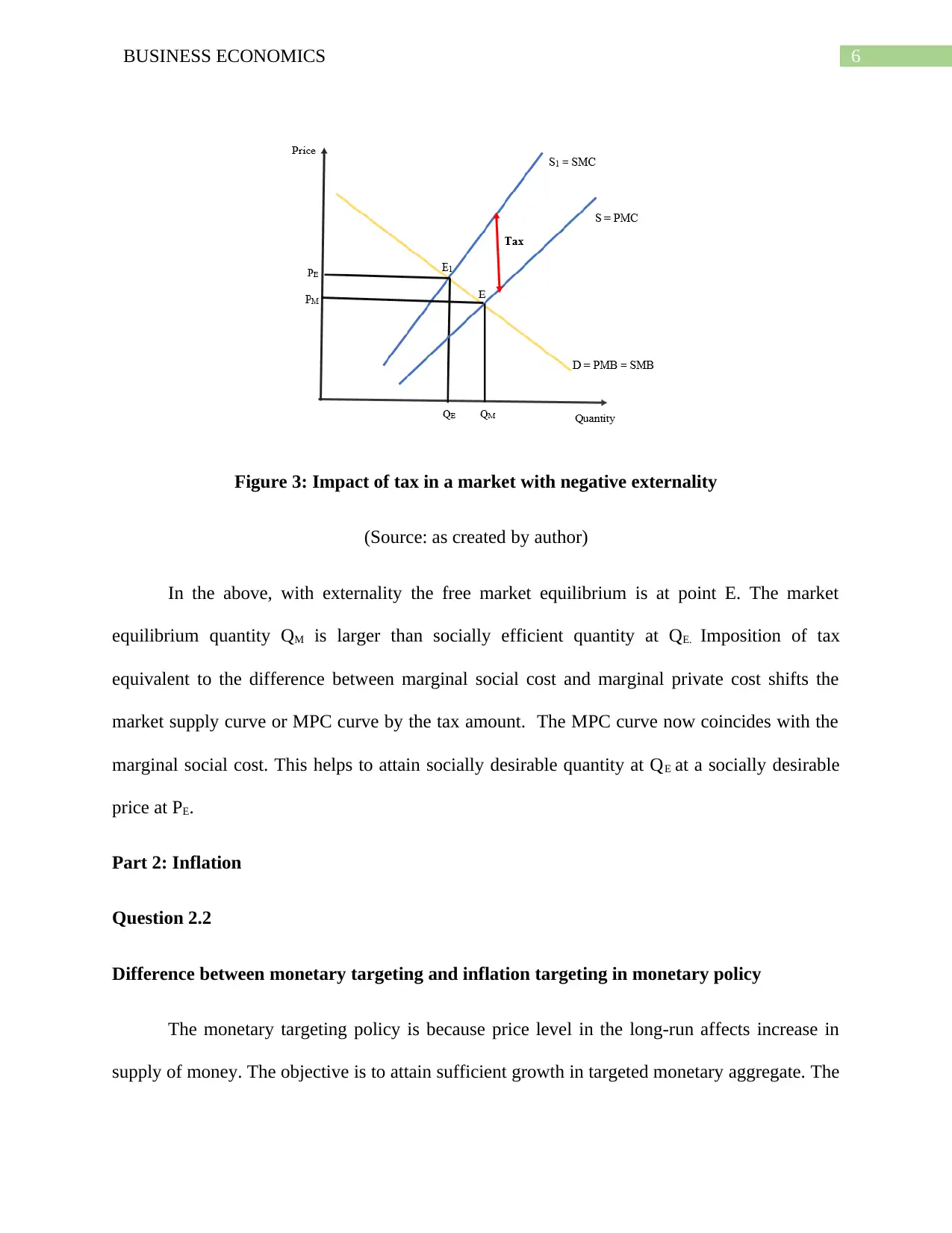
6BUSINESS ECONOMICS
Figure 3: Impact of tax in a market with negative externality
(Source: as created by author)
In the above, with externality the free market equilibrium is at point E. The market
equilibrium quantity QM is larger than socially efficient quantity at QE. Imposition of tax
equivalent to the difference between marginal social cost and marginal private cost shifts the
market supply curve or MPC curve by the tax amount. The MPC curve now coincides with the
marginal social cost. This helps to attain socially desirable quantity at QE at a socially desirable
price at PE.
Part 2: Inflation
Question 2.2
Difference between monetary targeting and inflation targeting in monetary policy
The monetary targeting policy is because price level in the long-run affects increase in
supply of money. The objective is to attain sufficient growth in targeted monetary aggregate. The
Figure 3: Impact of tax in a market with negative externality
(Source: as created by author)
In the above, with externality the free market equilibrium is at point E. The market
equilibrium quantity QM is larger than socially efficient quantity at QE. Imposition of tax
equivalent to the difference between marginal social cost and marginal private cost shifts the
market supply curve or MPC curve by the tax amount. The MPC curve now coincides with the
marginal social cost. This helps to attain socially desirable quantity at QE at a socially desirable
price at PE.
Part 2: Inflation
Question 2.2
Difference between monetary targeting and inflation targeting in monetary policy
The monetary targeting policy is because price level in the long-run affects increase in
supply of money. The objective is to attain sufficient growth in targeted monetary aggregate. The
Paraphrase This Document
Need a fresh take? Get an instant paraphrase of this document with our AI Paraphraser
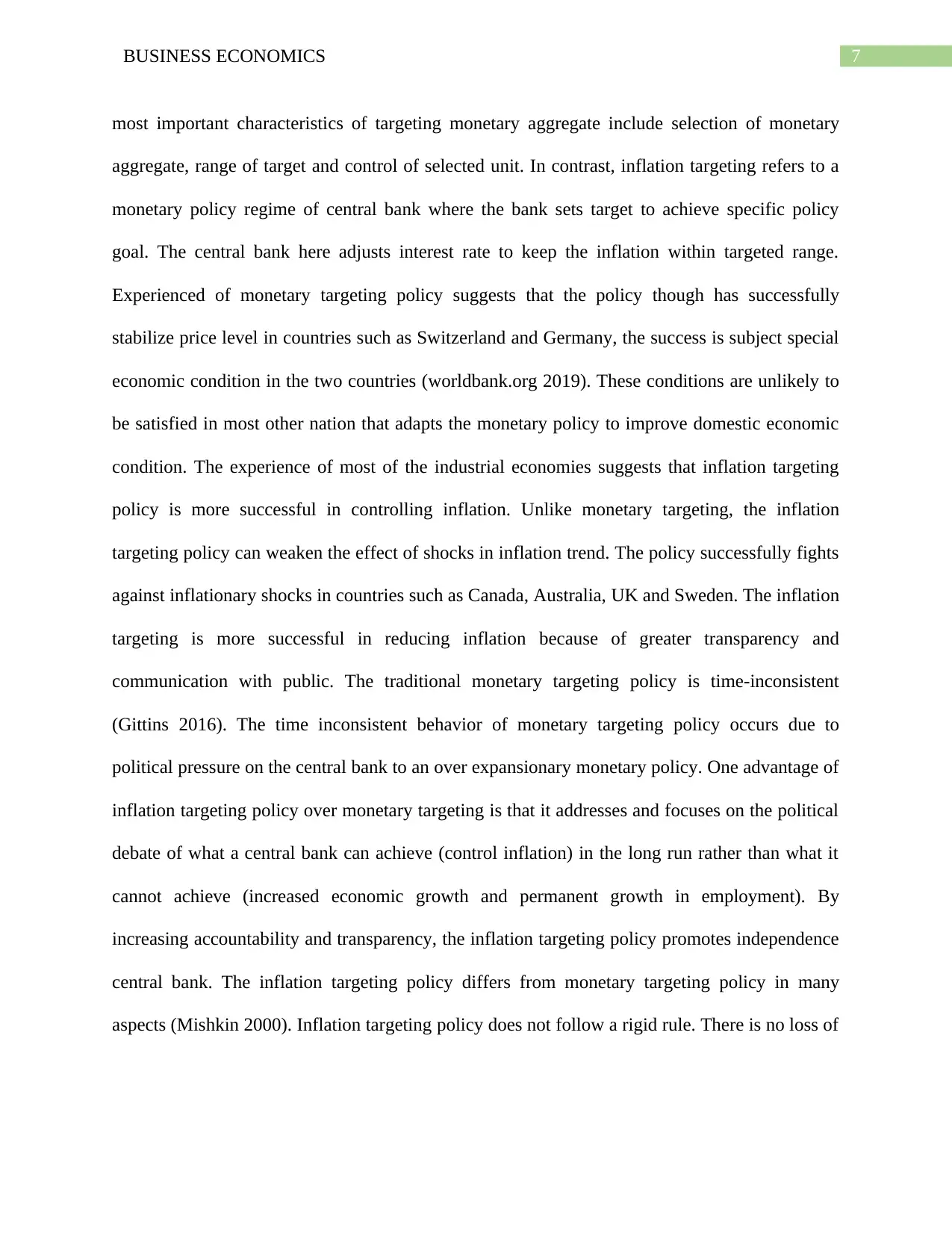
7BUSINESS ECONOMICS
most important characteristics of targeting monetary aggregate include selection of monetary
aggregate, range of target and control of selected unit. In contrast, inflation targeting refers to a
monetary policy regime of central bank where the bank sets target to achieve specific policy
goal. The central bank here adjusts interest rate to keep the inflation within targeted range.
Experienced of monetary targeting policy suggests that the policy though has successfully
stabilize price level in countries such as Switzerland and Germany, the success is subject special
economic condition in the two countries (worldbank.org 2019). These conditions are unlikely to
be satisfied in most other nation that adapts the monetary policy to improve domestic economic
condition. The experience of most of the industrial economies suggests that inflation targeting
policy is more successful in controlling inflation. Unlike monetary targeting, the inflation
targeting policy can weaken the effect of shocks in inflation trend. The policy successfully fights
against inflationary shocks in countries such as Canada, Australia, UK and Sweden. The inflation
targeting is more successful in reducing inflation because of greater transparency and
communication with public. The traditional monetary targeting policy is time-inconsistent
(Gittins 2016). The time inconsistent behavior of monetary targeting policy occurs due to
political pressure on the central bank to an over expansionary monetary policy. One advantage of
inflation targeting policy over monetary targeting is that it addresses and focuses on the political
debate of what a central bank can achieve (control inflation) in the long run rather than what it
cannot achieve (increased economic growth and permanent growth in employment). By
increasing accountability and transparency, the inflation targeting policy promotes independence
central bank. The inflation targeting policy differs from monetary targeting policy in many
aspects (Mishkin 2000). Inflation targeting policy does not follow a rigid rule. There is no loss of
most important characteristics of targeting monetary aggregate include selection of monetary
aggregate, range of target and control of selected unit. In contrast, inflation targeting refers to a
monetary policy regime of central bank where the bank sets target to achieve specific policy
goal. The central bank here adjusts interest rate to keep the inflation within targeted range.
Experienced of monetary targeting policy suggests that the policy though has successfully
stabilize price level in countries such as Switzerland and Germany, the success is subject special
economic condition in the two countries (worldbank.org 2019). These conditions are unlikely to
be satisfied in most other nation that adapts the monetary policy to improve domestic economic
condition. The experience of most of the industrial economies suggests that inflation targeting
policy is more successful in controlling inflation. Unlike monetary targeting, the inflation
targeting policy can weaken the effect of shocks in inflation trend. The policy successfully fights
against inflationary shocks in countries such as Canada, Australia, UK and Sweden. The inflation
targeting is more successful in reducing inflation because of greater transparency and
communication with public. The traditional monetary targeting policy is time-inconsistent
(Gittins 2016). The time inconsistent behavior of monetary targeting policy occurs due to
political pressure on the central bank to an over expansionary monetary policy. One advantage of
inflation targeting policy over monetary targeting is that it addresses and focuses on the political
debate of what a central bank can achieve (control inflation) in the long run rather than what it
cannot achieve (increased economic growth and permanent growth in employment). By
increasing accountability and transparency, the inflation targeting policy promotes independence
central bank. The inflation targeting policy differs from monetary targeting policy in many
aspects (Mishkin 2000). Inflation targeting policy does not follow a rigid rule. There is no loss of
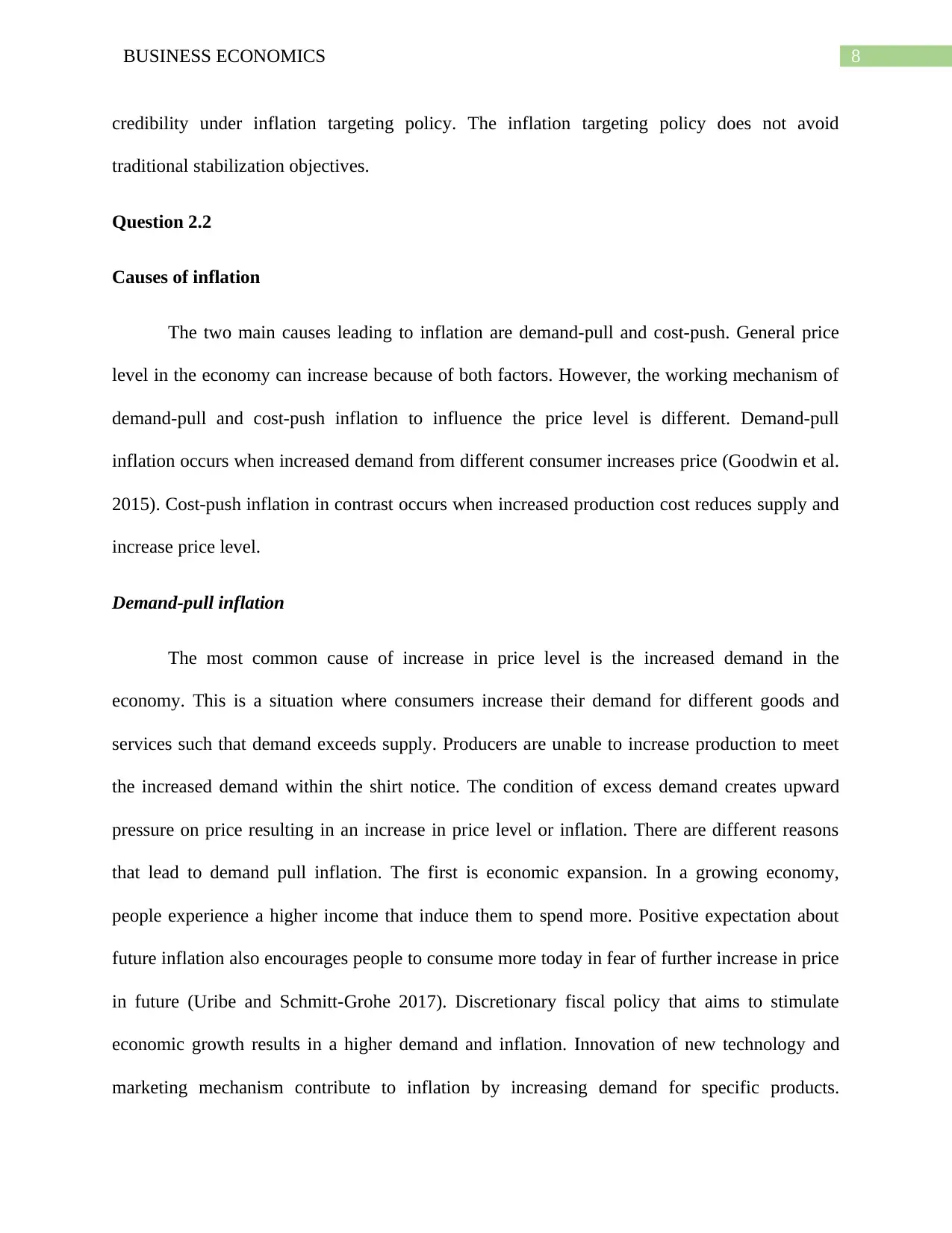
8BUSINESS ECONOMICS
credibility under inflation targeting policy. The inflation targeting policy does not avoid
traditional stabilization objectives.
Question 2.2
Causes of inflation
The two main causes leading to inflation are demand-pull and cost-push. General price
level in the economy can increase because of both factors. However, the working mechanism of
demand-pull and cost-push inflation to influence the price level is different. Demand-pull
inflation occurs when increased demand from different consumer increases price (Goodwin et al.
2015). Cost-push inflation in contrast occurs when increased production cost reduces supply and
increase price level.
Demand-pull inflation
The most common cause of increase in price level is the increased demand in the
economy. This is a situation where consumers increase their demand for different goods and
services such that demand exceeds supply. Producers are unable to increase production to meet
the increased demand within the shirt notice. The condition of excess demand creates upward
pressure on price resulting in an increase in price level or inflation. There are different reasons
that lead to demand pull inflation. The first is economic expansion. In a growing economy,
people experience a higher income that induce them to spend more. Positive expectation about
future inflation also encourages people to consume more today in fear of further increase in price
in future (Uribe and Schmitt-Grohe 2017). Discretionary fiscal policy that aims to stimulate
economic growth results in a higher demand and inflation. Innovation of new technology and
marketing mechanism contribute to inflation by increasing demand for specific products.
credibility under inflation targeting policy. The inflation targeting policy does not avoid
traditional stabilization objectives.
Question 2.2
Causes of inflation
The two main causes leading to inflation are demand-pull and cost-push. General price
level in the economy can increase because of both factors. However, the working mechanism of
demand-pull and cost-push inflation to influence the price level is different. Demand-pull
inflation occurs when increased demand from different consumer increases price (Goodwin et al.
2015). Cost-push inflation in contrast occurs when increased production cost reduces supply and
increase price level.
Demand-pull inflation
The most common cause of increase in price level is the increased demand in the
economy. This is a situation where consumers increase their demand for different goods and
services such that demand exceeds supply. Producers are unable to increase production to meet
the increased demand within the shirt notice. The condition of excess demand creates upward
pressure on price resulting in an increase in price level or inflation. There are different reasons
that lead to demand pull inflation. The first is economic expansion. In a growing economy,
people experience a higher income that induce them to spend more. Positive expectation about
future inflation also encourages people to consume more today in fear of further increase in price
in future (Uribe and Schmitt-Grohe 2017). Discretionary fiscal policy that aims to stimulate
economic growth results in a higher demand and inflation. Innovation of new technology and
marketing mechanism contribute to inflation by increasing demand for specific products.
⊘ This is a preview!⊘
Do you want full access?
Subscribe today to unlock all pages.

Trusted by 1+ million students worldwide
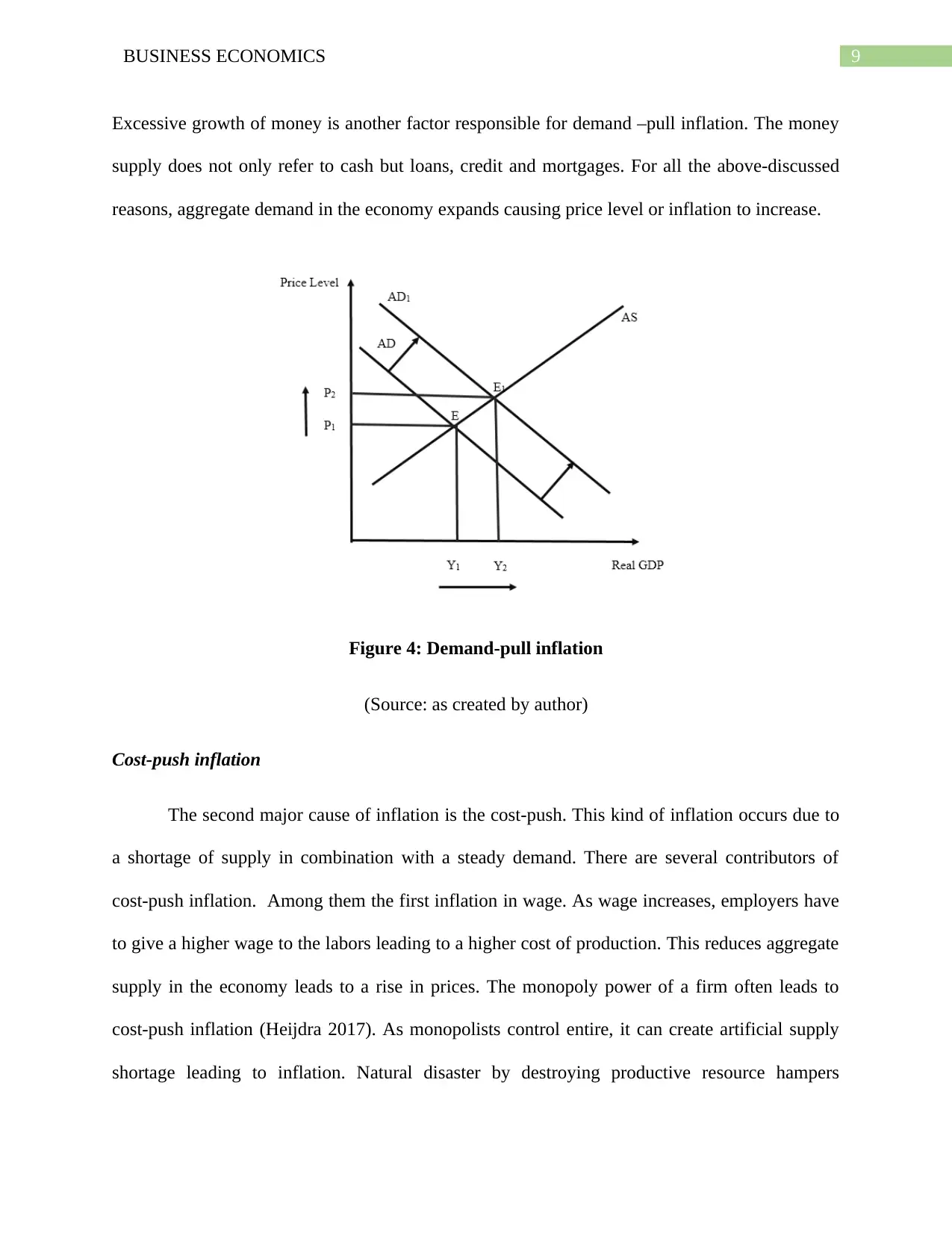
9BUSINESS ECONOMICS
Excessive growth of money is another factor responsible for demand –pull inflation. The money
supply does not only refer to cash but loans, credit and mortgages. For all the above-discussed
reasons, aggregate demand in the economy expands causing price level or inflation to increase.
Figure 4: Demand-pull inflation
(Source: as created by author)
Cost-push inflation
The second major cause of inflation is the cost-push. This kind of inflation occurs due to
a shortage of supply in combination with a steady demand. There are several contributors of
cost-push inflation. Among them the first inflation in wage. As wage increases, employers have
to give a higher wage to the labors leading to a higher cost of production. This reduces aggregate
supply in the economy leads to a rise in prices. The monopoly power of a firm often leads to
cost-push inflation (Heijdra 2017). As monopolists control entire, it can create artificial supply
shortage leading to inflation. Natural disaster by destroying productive resource hampers
Excessive growth of money is another factor responsible for demand –pull inflation. The money
supply does not only refer to cash but loans, credit and mortgages. For all the above-discussed
reasons, aggregate demand in the economy expands causing price level or inflation to increase.
Figure 4: Demand-pull inflation
(Source: as created by author)
Cost-push inflation
The second major cause of inflation is the cost-push. This kind of inflation occurs due to
a shortage of supply in combination with a steady demand. There are several contributors of
cost-push inflation. Among them the first inflation in wage. As wage increases, employers have
to give a higher wage to the labors leading to a higher cost of production. This reduces aggregate
supply in the economy leads to a rise in prices. The monopoly power of a firm often leads to
cost-push inflation (Heijdra 2017). As monopolists control entire, it can create artificial supply
shortage leading to inflation. Natural disaster by destroying productive resource hampers
Paraphrase This Document
Need a fresh take? Get an instant paraphrase of this document with our AI Paraphraser
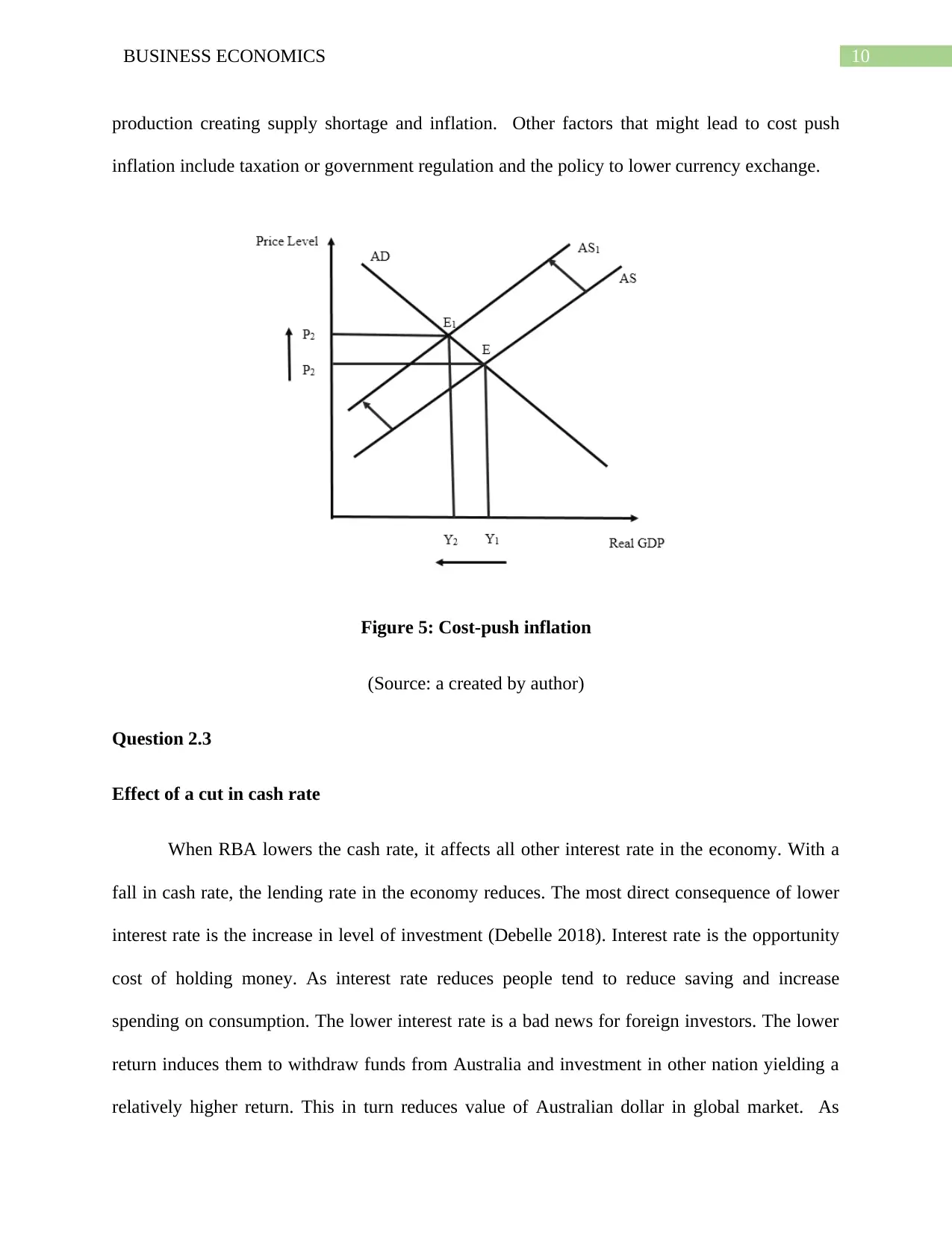
10BUSINESS ECONOMICS
production creating supply shortage and inflation. Other factors that might lead to cost push
inflation include taxation or government regulation and the policy to lower currency exchange.
Figure 5: Cost-push inflation
(Source: a created by author)
Question 2.3
Effect of a cut in cash rate
When RBA lowers the cash rate, it affects all other interest rate in the economy. With a
fall in cash rate, the lending rate in the economy reduces. The most direct consequence of lower
interest rate is the increase in level of investment (Debelle 2018). Interest rate is the opportunity
cost of holding money. As interest rate reduces people tend to reduce saving and increase
spending on consumption. The lower interest rate is a bad news for foreign investors. The lower
return induces them to withdraw funds from Australia and investment in other nation yielding a
relatively higher return. This in turn reduces value of Australian dollar in global market. As
production creating supply shortage and inflation. Other factors that might lead to cost push
inflation include taxation or government regulation and the policy to lower currency exchange.
Figure 5: Cost-push inflation
(Source: a created by author)
Question 2.3
Effect of a cut in cash rate
When RBA lowers the cash rate, it affects all other interest rate in the economy. With a
fall in cash rate, the lending rate in the economy reduces. The most direct consequence of lower
interest rate is the increase in level of investment (Debelle 2018). Interest rate is the opportunity
cost of holding money. As interest rate reduces people tend to reduce saving and increase
spending on consumption. The lower interest rate is a bad news for foreign investors. The lower
return induces them to withdraw funds from Australia and investment in other nation yielding a
relatively higher return. This in turn reduces value of Australian dollar in global market. As
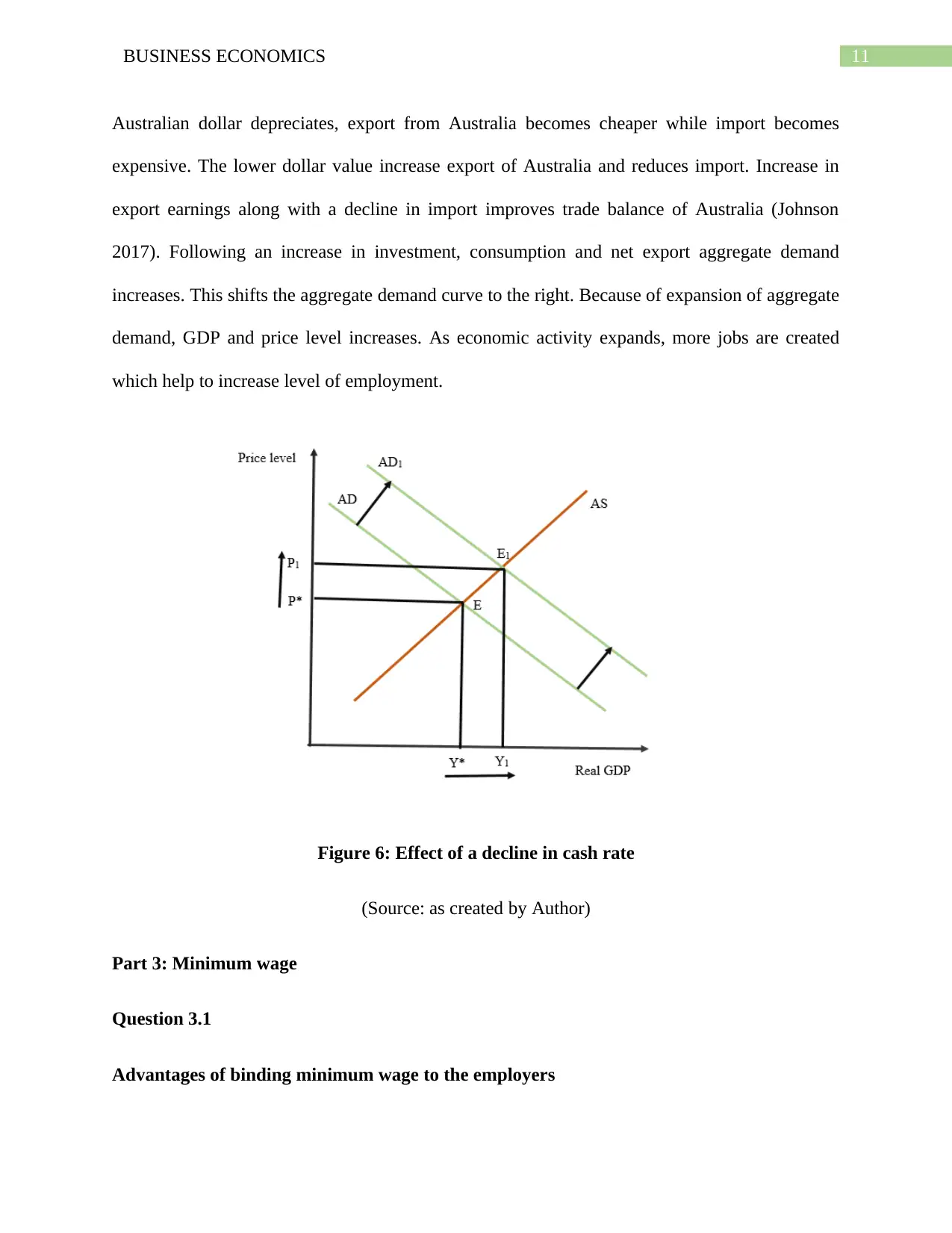
11BUSINESS ECONOMICS
Australian dollar depreciates, export from Australia becomes cheaper while import becomes
expensive. The lower dollar value increase export of Australia and reduces import. Increase in
export earnings along with a decline in import improves trade balance of Australia (Johnson
2017). Following an increase in investment, consumption and net export aggregate demand
increases. This shifts the aggregate demand curve to the right. Because of expansion of aggregate
demand, GDP and price level increases. As economic activity expands, more jobs are created
which help to increase level of employment.
Figure 6: Effect of a decline in cash rate
(Source: as created by Author)
Part 3: Minimum wage
Question 3.1
Advantages of binding minimum wage to the employers
Australian dollar depreciates, export from Australia becomes cheaper while import becomes
expensive. The lower dollar value increase export of Australia and reduces import. Increase in
export earnings along with a decline in import improves trade balance of Australia (Johnson
2017). Following an increase in investment, consumption and net export aggregate demand
increases. This shifts the aggregate demand curve to the right. Because of expansion of aggregate
demand, GDP and price level increases. As economic activity expands, more jobs are created
which help to increase level of employment.
Figure 6: Effect of a decline in cash rate
(Source: as created by Author)
Part 3: Minimum wage
Question 3.1
Advantages of binding minimum wage to the employers
⊘ This is a preview!⊘
Do you want full access?
Subscribe today to unlock all pages.

Trusted by 1+ million students worldwide
1 out of 20
Related Documents
Your All-in-One AI-Powered Toolkit for Academic Success.
+13062052269
info@desklib.com
Available 24*7 on WhatsApp / Email
![[object Object]](/_next/static/media/star-bottom.7253800d.svg)
Unlock your academic potential
Copyright © 2020–2025 A2Z Services. All Rights Reserved. Developed and managed by ZUCOL.





